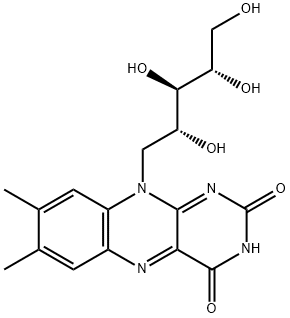83-88-5

Product Name:
Riboflavin
Formula:
C17H20N4O6
Synonyms:
Riboflavin;Vitamin B2;Riboflavine;(?)-Riboflavin;Lactoflavin
Inquiry
CHEMICAL AND PHYSICAL PROPERTIES
| Physical Description | Yellow to orange-yellow crystalline powder, with slight odour |
|---|---|
| Color/Form | Fine orange-yellow needles from 2N acetic acid, alcohol, water, or pyridine ... three different crystal forms |
| Odor | Slight odor |
| Taste | Bitter |
| Melting Point | 280 dec °C |
| Solubility | 84.7 mg/L (at 25 °C) |
| LogP | -1.46 |
| LogS | -3.68 |
| Stability/Shelf Life | Crystalline riboflavin shows no evidence of decomposition under ordinary conditions, but protection from light is advisable |
| Optical Rotation | [α]D/20 between – 115° and – 140° in a 0,05 N sodium hydroxide solution |
| Decomposition | When heated to decomposition it emits toxic fumes of /nitric oxide/. |
| pH | pH of saturated aqueous solution: about 6 |
| Dissociation Constants | 10.2 |
| Collision Cross Section | 188.3 Ų [M+H]+ [CCS Type: DT, Method: single field calibrated with Agilent tune mix (Agilent)] |
| Other Experimental Properties | Visible or ultraviolet radiation of alkaline solutions causes the formation of lumiflavine ... whereas irradiation of acid or neutral solutions gives rise to the production of lumichrome ... togther with varying amounts of lumiflavine |
| Chemical Classes | Biological Agents -> Vitamins and Derivatives |
SAFETY INFORMATION
| Signal word | Danger |
|---|---|
| Pictogram(s) |
 Flame Flammables GHS02  Skull and Crossbones Acute Toxicity GHS06  Health Hazard GHS08 |
| GHS Hazard Statements |
H226:Flammable liquids H370:Specific target organ toxicity, single exposure |
| Precautionary Statement Codes |
P210:Keep away from heat/sparks/open flames/hot surfaces. — No smoking. P280:Wear protective gloves/protective clothing/eye protection/face protection. |
COMPUTED DESCRIPTORS
| Molecular Weight | 376.4 g/mol |
|---|---|
| XLogP3 | -1.5 |
| Hydrogen Bond Donor Count | 5 |
| Hydrogen Bond Acceptor Count | 7 |
| Rotatable Bond Count | 5 |
| Exact Mass | 376.13828437 g/mol |
| Monoisotopic Mass | 376.13828437 g/mol |
| Topological Polar Surface Area | 155 Ų |
| Heavy Atom Count | 27 |
| Formal Charge | 0 |
| Complexity | 680 |
| Isotope Atom Count | 0 |
| Defined Atom Stereocenter Count | 3 |
| Undefined Atom Stereocenter Count | 0 |
| Defined Bond Stereocenter Count | 0 |
| Undefined Bond Stereocenter Count | 0 |
| Covalently-Bonded Unit Count | 1 |
| Compound Is Canonicalized | Yes |
PRODUCT INTRODUCTION
Description
In the 1920s, a water-soluble B fraction was discovered to contain a yellow, fluorescent growth factor known as riboflavin in England and vitamin G in the United States. In the early 1930s, several research groups identified the coenzyme forms of riboflavin, including 50-phosphate (flavin mononucleotide) and its further conjugate with adenylic acid (flavin adenine dinucleotide).
